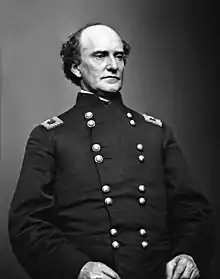Julius White
Julius White (September 23, 1816 – May 12, 1890) was a brigadier general in the Union Army during the American Civil War, as well as a postbellum diplomat.
Julius White | |
|---|---|
 | |
| Born | September 23, 1816 Cazenovia, New York |
| Died | May 12, 1890 (aged 73) Evanston, Illinois |
| Place of burial | Rosehill Cemetery, Chicago, Illinois |
| Allegiance | United States of America Union |
| Service/ | United States Army Union Army |
| Years of service | 1861–1865 |
| Rank | |
| Battles/wars | American Civil War |
Civil War
A lawyer before the war, White received a commission as colonel of the 37th Illinois Volunteer Infantry Regiment on September 19, 1861. He led the regiment in the southwest Missouri campaign of John C. Fremont in late 1861. At the Battle of Pea Ridge on March 7, 1862, his brigade of two Illinois regiments blunted the attack of Louis Hebert's Confederates. On March 8 his troops participated in the final attack that defeated the Southern army.
White was promoted brigadier general on June 9, 1862, and led the "Railroad" Brigade, VIII Corps.[1] During the Second Battle of Bull Run, this unit was posted in Martinsburg, West Virginia, on the Baltimore & Ohio Railroad. In the face of Robert E. Lee's invasion of Maryland, White retreated into Harper's Ferry, West Virginia, and joined Colonel Dixon S. Miles and his large garrison there. "White outranked Miles, but he followed military protocol by putting himself under the officer commanding on the scene in a crisis."[2] This was an unfortunate decision for White because Miles proved to be incapable of mounting an effective defense of the position. The Battle of Harpers Ferry was fought Sept 12-15, 1862, from a highly disadvantageous position compounded by Miles's numerous strategic mistakes. After he ran up the white flag, one of the last shots mortally wounded Miles. Therefore, White had to carry out the formal surrender of the place. For surrendering, White was brought before a court of inquiry, but he was acquitted when the court "found that he acted with capability and courage."[3]
White was assigned to the XXIII Corps where he commanded the 2nd Division in the Knoxville Campaign in 1863.[4] In July 1864 he was sent to the Eastern Theater to command a division in the IX Corps. He briefly served as Ambrose Burnside's chief of staff during the battle of the Crater. He commanded the 1st Division in the IX Corps at the battle of Globe Tavern. This division was discontinued late in the Summer of 1864 and White resigned on November 19, 1864. He was breveted major general for war service and later served as U.S. Minister to Argentina from November 1873 to March 1874.[3]
References
- Battles and Leaders of the Civil War, Volume 3. Secaucus, NJ: Castle. ISBN 0-89009-571-X
- Boatner, Mark M. III. The Civil War Dictionary. New York: David McKay, 1959. ISBN 0-679-50013-8
- Eicher, John H., and Eicher, David J., Civil War High Commands, Stanford University Press, 2001, ISBN 0-8047-3641-3.
- Sears, Stephen W. Landscape Turned Red: The Battle of Antietam. New Haven: Ticknor & Fields, 1983. ISBN 0-89919-172-X
Footnotes
- Eicher p.566
- Sears, p. 122.
- Boatner, p. 914.
- Battles & Leaders, p. 751.
External links
- "Julius White". Find a Grave. Retrieved 2012-12-07.
